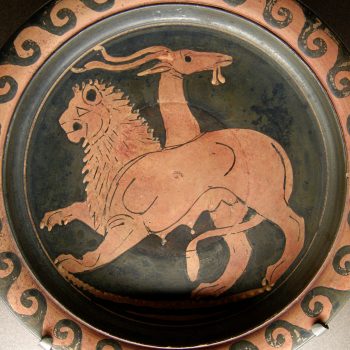Reaching within: What traditional art offers the heart

The allegorical painting of Italian 18th-century artist Pompeo Batoni reflects a much-needed understanding of the relationship between peace and war for a contemporary audience. In “Allegory of Peace and War,” Batoni depicts symbolic representations of Peace as feminine, soft, and graceful; and War as masculine, strong, and fierce. It is the nature of their communication that is the most interesting.

War is shown in full armor as if ready for battle. His armor depicts a dragon, ram, and lion, which are sometimes associated with the Chimera, a mythological creature that is an omen for misfortune. War’s sword is unsheathed and his shield is fully equipped. Darkness engulfs the figures, making this a scene fringed with a sense of coming devastation.
Peace, in her soft grace, contrasts the hard appearance of War. She is relaxed and calm and meets the fierceness of War’s gaze with a loving one of her own. She gently places her hand on War’s sword, a touch seemingly light and gentle but the weight of which pushes War’s arm back. She presents to him an olive branch, a symbol for peace. War is distracted by Peace: He has forgotten the conflict that drives his very nature and protects her with the shield he reserves for himself.
What does this all mean? Peace and war seem to occur in a perpetual cycle, as the saying “history repeats itself” suggests. We all desire peace as human beings. We all want to enjoy our lives. We traditionally have a propensity to respect the sacredness of life, beginning with our own and then extending that respect to others. We appreciate and desire peace.
Yet conflict finds ways to rear its head after peace no longer distracts it from achieving its goals. Peace, victim to its own lullaby, falls asleep under the guise of its own complacency. That is, we can be victims of our own comfort in times of peace and excess, and then we engage in a game of blame and negativity that inevitably leads to violence. We then find conflict in places where conflict may not exist.
War and conflict, like a plant’s roots that need the resistance of the earth to grow strong and move upward toward the sun, seem to be necessary in history: Conflict comes forth to present to human beings a way to move forward through compromise and resolution. But conflict becomes dangerous when it becomes a practice for its own sake because, of course, whatever we practice, we strengthen.
Conflict in Postmodern Times

This blame game seems to be a prevalent characteristic of our postmodern existence. Unfortunately, this tendency allows us to avoid taking responsibility for our own shortcomings as individuals and as members of a larger community: It dwarfs our growth in both respects. It becomes a dangerous game when peace is not present to balance the conflictual nature of war.
In recent history, conflict and negativity are and have been justified as a means to peace. Traditional social forms are constantly battered, critiqued, and criticized in hopes of extending the boundaries of individual freedom. This is, however, a practice and exercise in delimiting. It tightens its chains of negativity around its adherents on a path to a destination that is never fully explained. In other words, our postmodern existence encourages the practice of conflict as a means toward free exploration of personal identity, without ever providing an explanation of how this practice of conflict will result in peace.
Batoni depicts the nature of Peace differently: Peace is depicted as unmoved by the conflict embodied by War. Peace is not reactionary. Peace meets War with what is in her nature: to be gentle and graceful toward reconciliation and resolution. To meet War with conflict and negativity is just to perpetuate the very things that are to be resolved. She instead presents not just some random thing but a gift full of meaning. The gift of the olive branch is a representation of peace, and as such, it is a gift of herself. She is not blaming War for the darkness that surrounds them or the fact that his sword and shield are prepared for battle. She instead shares who she is positively. War cannot help but be distracted from his goals.

How can peace be practiced to balance and soften the practice of conflict? Practicing peace requires resolve and positivity in the face of negativity and conflict. It requires finding what may be mutual ground to begin reconciliation and resolution. It requires giving the gift of oneself both in terms of presenting one’s own perspective and in terms of listening to others’ perspectives. It requires respect, love, and harmony as a practice for their own sakes. Those who practice positivity and peace in the face of negativity and conflict may later find that those who were once negative toward them now shield them from harm.
Art has an incredible ability to point to what can’t be seen so that we may ask “What does this mean for me and for everyone who sees it?” “How has it influenced the past and how might it influence the future?” “What does it suggest about the human experience?” These are some of the questions I will explore in my series Reaching Within: What Traditional Art Offers the Heart.
Eric Bess is a practicing representational artist. He is currently a doctoral student at the Institute for Doctoral Studies in the Visual Arts (IDSVA).
Contributed by Eric Bess
